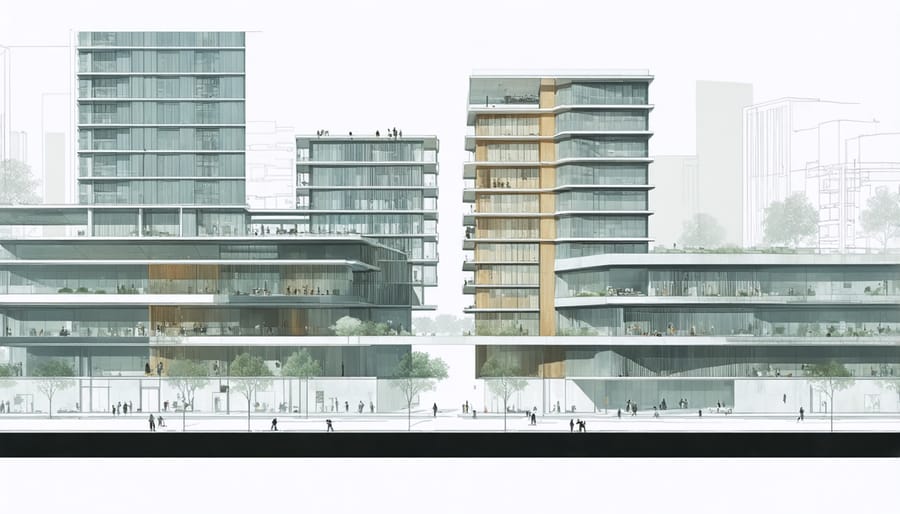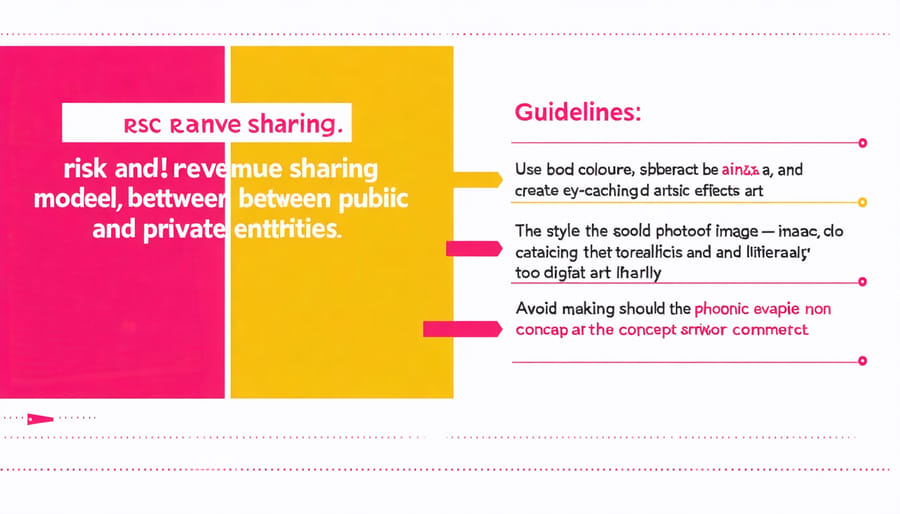Public-private partnerships (PPP) have revolutionized real estate development, creating a powerful collaboration model that maximizes resource efficiency while minimizing risk exposure. By combining government oversight with private sector innovation, these partnerships have transformed urban landscapes across global markets, delivering projects that neither sector could accomplish independently.
Recent data reveals that PPP real estate developments consistently outperform traditional development models, achieving 30% faster completion rates and 25% greater return on investment when structured correctly. From transit-oriented developments to mixed-use urban renewal projects, this approach has proven particularly effective in complex, large-scale initiatives requiring substantial capital investment and specialized expertise.
The strategic alignment of public authority with private sector efficiency creates a unique value proposition: governments maintain control over critical infrastructure and community benefits while leveraging private sector capital and operational expertise. This synergy has become increasingly crucial as municipalities face budget constraints yet must address growing urban development challenges.
For construction professionals and developers, understanding the intricacies of PPP structures represents both an opportunity and a necessity in today’s competitive market. Success in this space demands mastery of complex regulatory frameworks, innovative financing mechanisms, and stakeholder management – skills that distinguish industry leaders in an evolving real estate landscape.
The Evolution of Public-Private Partnerships in Real Estate
Traditional vs. Modern PPP Models
Traditional PPP models in real estate development historically relied on straightforward contractual arrangements, with governments typically maintaining significant control over project operations and assuming most risks. These early partnerships often featured simple lease agreements or basic revenue-sharing models, limiting private sector innovation and efficiency.
Modern PPP frameworks have evolved significantly, introducing more sophisticated and effective partnership structures that better distribute risks and responsibilities. Contemporary models emphasize value engineering, life-cycle cost optimization, and integrated project delivery approaches, allowing private partners greater autonomy in design and implementation decisions.
Key differences include:
1. Risk Allocation: Modern structures employ detailed risk matrices and sophisticated risk-sharing mechanisms, unlike traditional models where public entities bore most risks.
2. Financial Innovation: Contemporary PPPs utilize complex financing instruments, including hybrid funding models and performance-based payment mechanisms, compared to conventional government-backed funding.
3. Performance Metrics: Today’s partnerships incorporate comprehensive KPIs and output-based specifications, replacing simple input-based requirements of traditional models.
4. Technology Integration: Modern PPPs leverage advanced digital tools and building information modeling (BIM), enabling better collaboration and project optimization throughout the development lifecycle.
This evolution reflects growing market sophistication and the need for more efficient, sustainable development solutions that better serve both public and private stakeholders.

Key Stakeholders and Their Roles
In successful public-private partnership real estate developments, stakeholders from both sectors play distinct yet complementary roles, each bringing unique resources and expertise to the project. The public sector, typically represented by government agencies and municipalities, primarily contributes through regulatory oversight, land provision, and infrastructure support. They often facilitate zoning changes, provide tax incentives, and ensure project alignment with community needs and public policy objectives.
Private sector stakeholders, including developers, investors, and construction firms, bring technical expertise, financial capital, and market knowledge. These entities assume primary responsibility for project execution, construction management, and operational efficiency. Financial institutions play a crucial role by providing project financing, while architectural and engineering firms contribute design expertise and technical solutions.
Community stakeholders, though not direct partners, significantly influence project outcomes through public consultations and feedback mechanisms. Their input helps shape development plans and ensure community benefits are adequately addressed.
Legal counsel representing both public and private entities ensures proper risk allocation and contract structuring. Project success often hinges on clear delineation of responsibilities, with public sector focusing on policy framework and approval processes, while private partners manage development execution and asset management.
The most effective partnerships maintain balanced risk-sharing arrangements, where each stakeholder’s responsibilities align with their expertise and capacity to manage specific project aspects. This strategic allocation of roles creates a framework for sustainable project delivery and long-term value creation.
Strategic Benefits of PPP Real Estate Projects

Risk Sharing and Financial Innovation
In successful public-private partnership real estate developments, risk sharing and financial innovation play pivotal roles in project viability. The allocation of risks between public and private entities follows a fundamental principle: risks should be assigned to the party best equipped to manage them. This approach has revolutionized modern infrastructure development by creating more efficient risk management frameworks.
Financial institutions have developed sophisticated funding mechanisms to support these partnerships. These include hybrid financing structures that combine traditional debt instruments with innovative capital market solutions. Project finance arrangements typically incorporate multiple layers of funding, including senior debt, mezzanine financing, and equity contributions from both public and private partners.
Risk mitigation strategies often include performance bonds, completion guarantees, and specialized insurance products. The private sector usually assumes construction and operational risks, while the public sector manages regulatory and political risks. This balanced approach has proven particularly effective in large-scale urban development projects where multiple stakeholders are involved.
Recent innovations include green bonds for sustainable development projects and social impact investments that align with public policy objectives. Value capture mechanisms, such as tax increment financing (TIF) and special assessment districts, have become increasingly popular tools for funding infrastructure improvements within PPP developments.
The success of these financial structures depends on careful documentation of risk allocation through comprehensive agreements that clearly define responsibilities, performance metrics, and dispute resolution procedures. This systematic approach to risk management has significantly improved project bankability and attracted institutional investors to the PPP real estate sector.
Community Impact and Social Value
Public-private partnership real estate developments create significant social and economic value beyond their physical structures. These projects often serve as catalysts for neighborhood revitalization, generating employment opportunities during both construction and operational phases. Studies indicate that successful PPP developments can increase local property values by 15-30% while providing essential community amenities such as affordable housing, public spaces, and improved infrastructure.
The socio-economic benefits extend to multiple stakeholders. Local governments benefit from expanded tax bases and reduced infrastructure maintenance costs, while residents gain access to integrated developments that combine housing, retail, and public facilities. These projects frequently incorporate sustainable design elements and community-focused amenities like parks, educational facilities, and healthcare centers, enhancing quality of life for local populations.
PPP developments also address crucial urban challenges such as housing affordability and economic disparity. Many projects include mandatory affordable housing components, typically allocating 20-30% of residential units to below-market rates. This integration promotes social diversity and helps create more inclusive communities. Furthermore, these developments often incorporate workforce development programs, providing training and employment opportunities for local residents.
The multiplier effect of PPP real estate projects generates substantial economic impact. Research shows that every dollar invested in PPP developments typically generates $2.50 in local economic activity through job creation, increased consumer spending, and business growth. Additionally, these projects often catalyze further private investment in surrounding areas, creating sustainable economic growth corridors.
Community engagement plays a vital role in maximizing social value. Successful PPP projects involve extensive stakeholder consultation, ensuring developments align with community needs and preferences while preserving local character and cultural heritage.
Success Factors in PPP Real Estate Development
Legal and Regulatory Framework
The legal and regulatory framework governing public-private partnership real estate developments encompasses multiple layers of legislation and oversight mechanisms. At the federal level, key regulations include procurement laws, environmental standards, and public financing guidelines that shape project structure and implementation. State and local jurisdictions often maintain additional requirements, particularly regarding zoning, land use, and development permits.
Successful PPP projects require careful navigation of contractual obligations between public and private entities. These typically include detailed provisions for risk allocation, performance standards, revenue sharing, and dispute resolution mechanisms. Essential regulatory considerations include compliance with public bidding requirements, environmental impact assessments, and fair housing regulations when applicable.
Project stakeholders must also address transparency and accountability measures mandated by public sector involvement. This includes adhering to open meeting laws, public record requirements, and financial disclosure regulations. Private developers must demonstrate compliance with prevailing wage requirements, minority business enterprise participation goals, and local hiring initiatives often attached to public projects.
The regulatory landscape continues to evolve, with increasing emphasis on sustainability standards and community benefit agreements. Development teams should engage legal counsel experienced in PPP structures early in the planning process to ensure compliance and optimize project outcomes. Regular monitoring of regulatory changes and maintaining open communication channels with oversight agencies helps prevent compliance issues during project execution.
Effective Project Management Strategies
Managing complex public-private partnership developments requires a sophisticated approach that balances multiple stakeholders’ interests while maintaining project momentum. Drawing from successful PPP implementations, several key strategies have emerged as industry best practices.
Establishing a robust governance framework at project inception is crucial. This should include clear decision-making protocols, risk allocation matrices, and performance metrics. Project managers must implement comprehensive communication systems that facilitate transparent information flow between public agencies, private developers, contractors, and other stakeholders.
Risk management demands particular attention in PPP developments. Successful project managers employ dynamic risk assessment tools and maintain detailed contingency plans for various scenarios. Regular stakeholder meetings and progress reviews help identify potential issues before they impact project timelines or budgets.
Technology integration plays a vital role in modern PPP management. Building Information Modeling (BIM) and project management software enable real-time collaboration and progress tracking. These tools should be coupled with traditional project controls like earned value management and critical path scheduling.
Quality assurance protocols must be rigorous and well-documented. This includes regular third-party inspections, compliance audits, and systematic documentation of all project phases. Environmental and social impact assessments should be ongoing throughout the project lifecycle, ensuring sustainable development practices are maintained.
Financial monitoring requires sophisticated tracking systems that account for both public and private funding streams, ensuring transparency and accountability in resource allocation.
Stakeholder Engagement and Communication
Effective stakeholder engagement and communication serve as the cornerstone of successful public-private partnership real estate developments. The complex nature of these projects demands a structured approach to managing relationships between public entities, private developers, investors, community members, and other key stakeholders.
Regular stakeholder meetings, transparent reporting mechanisms, and clear communication channels help maintain alignment between all parties’ objectives. Successful PPP projects often establish dedicated project management offices (PMOs) that coordinate communication efforts and ensure consistent messaging across all stakeholder groups.
Documentation plays a crucial role in maintaining accountability and trust. This includes detailed progress reports, financial updates, and milestone achievements shared through established protocols. Regular forums for stakeholder feedback and conflict resolution mechanisms should be implemented early in the project lifecycle.
Community engagement deserves particular attention, as public support can significantly impact project success. This involves organizing public consultations, maintaining open dialogue with neighborhood associations, and addressing concerns proactively rather than reactively.
Risk communication strategies must be developed to manage stakeholder expectations and prepare for potential challenges. This includes creating contingency plans and establishing clear protocols for crisis communication.
Digital platforms and project management tools can streamline communication processes, ensuring real-time updates and efficient information sharing among all parties. These technologies help maintain transparency and facilitate quick decision-making while creating an audit trail of all stakeholder interactions.


Case Study: The Manchester City Centre Regeneration Project
The Manchester City Centre Regeneration Project stands as a landmark example of successful public-private partnership in real estate development, transforming a post-industrial urban landscape into a thriving mixed-use district. Launched in 2011, this £800 million initiative represents one of the UK’s most ambitious urban regeneration projects, involving collaboration between Manchester City Council, private developers, and institutional investors.
The project’s success hinged on strategic risk allocation, with the public sector providing land assembly and planning framework while private partners managed construction and commercial risks. The development encompassed 24 hectares of brownfield land, delivering 1,300 residential units, 150,000 square meters of commercial space, and 50,000 square meters of retail facilities.
Key success factors included:
1. Transparent governance structure: A dedicated Special Purpose Vehicle (SPV) was established, ensuring clear decision-making processes and accountability.
2. Phased development approach: The project was divided into manageable phases, allowing for risk mitigation and market adaptation.
3. Innovative funding mechanism: A combination of public sector grants, private equity, and institutional investment created a sustainable financial model.
4. Community engagement: Early stakeholder consultation resulted in modifications that enhanced public support and project viability.
The financial structure demonstrated particular innovation, with the local authority contributing land valued at £140 million while maintaining a 20% equity stake. Private sector partners invested £660 million, sharing both risks and returns proportionally.
Notable outcomes include:
– 12,000 new jobs created
– 30% increase in local property values
– 40% reduction in carbon emissions through sustainable design
– £2.4 billion estimated economic impact over 15 years
Challenges faced during implementation included contaminated land remediation, heritage preservation requirements, and market fluctuations. These were addressed through adaptive management strategies and strong partnership frameworks.
The project’s success has established a replicable model for large-scale urban regeneration, demonstrating how effective public-private partnerships can deliver both commercial returns and social benefits. The development has received multiple awards for design excellence and sustainable development practices, setting new standards for PPP initiatives in the construction sector.
As we look to the future of real estate development, public-private partnerships are poised to play an increasingly vital role in addressing complex urban challenges and infrastructure needs. The evolution of PPP models has demonstrated their resilience and adaptability, particularly in navigating economic uncertainties and changing market demands.
Industry professionals should recognize that successful PPP implementations in real estate development will increasingly depend on technological integration, sustainability considerations, and community engagement. The rise of smart city initiatives and sustainable building practices presents new opportunities for innovative partnership structures that can better serve both public interests and private sector objectives.
Key takeaways for industry stakeholders include the importance of early stakeholder engagement, robust risk assessment frameworks, and flexible contract structures that can adapt to changing market conditions. The most successful PPP projects will be those that effectively balance public benefit with private sector returns while maintaining transparency and accountability throughout the development process.
Looking ahead, we can expect to see more sophisticated financing mechanisms, including green bonds and social impact investments, becoming integral to PPP structures. The integration of ESG (Environmental, Social, and Governance) criteria into project planning and execution will likely become standard practice, reflecting growing investor and public consciousness about sustainable development.
For construction professionals and project managers, staying current with emerging PPP best practices and regulatory frameworks will be crucial. This includes developing expertise in digital collaboration tools, understanding complex financing structures, and mastering stakeholder management techniques.
The future success of PPP real estate developments will largely depend on the industry’s ability to learn from past experiences, adapt to new challenges, and embrace innovative solutions. As cities continue to grow and evolve, the partnership between public and private sectors will remain fundamental to delivering high-quality, sustainable real estate projects that serve community needs while generating acceptable returns for investors.
Professionals who can effectively navigate these partnerships, understanding both public sector priorities and private sector imperatives, will be well-positioned to lead the next generation of successful real estate development projects.

